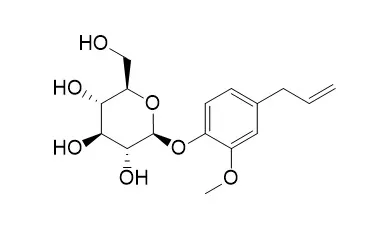| In vitro: |
| Biomolecules . 2021 Jan 27;11(2):172. | | Human Saliva-Mediated Hydrolysis of Eugenyl-β-D-Glucoside and Fluorescein-di-β-D-Glucoside in In Vivo and In Vitro Models[Pubmed: 33514072] | | Eugenyl-β-D-glucopyranoside, also referred to as Citrusin C, is a natural glucoside found among others in cloves, basil and cinnamon plants. Eugenol in a form of free aglycone is used in perfumeries, flavourings, essential oils and in medicinal products. Synthetic Citrusin C was incubated with human saliva in several in vitro models together with substrate-specific enzyme and antibiotics (clindamycin, ciprofloxacin, amoxicillin trihydrate and potassium clavulanate). Citrusin C was detected using liquid chromatography with tandem mass spectrometry (LC-MS/MS). Citrusin C was completely degraded only when incubated with substrate-specific A. niger glucosidase E.C 3.2.1.21 (control sample) and when incubated with human saliva (tested sample). The addition of antibiotics to the above-described experimental setting, stopped Citrusin C degradation, indicating microbiologic origin of hydrolysis observed. Our results demonstrate that Citrusin C is subjected to complete degradation by salivary/oral cavity microorganisms. Extrapolation of our results allows to state that in the human oral cavity, virtually all β-D-glucosides would follow this type of hydrolysis. Additionally, a new method was developed for an in vivo rapid test of glucosidase activity in the human mouth on the tongue using fluorescein-di-β-D-glucoside as substrate. The results presented in this study serve as a proof of concept for the hypothesis that microbial hydrolysis path of β-D-glucosides begins immediately in the human mouth and releases the aglycone directly into the gastrointestinal tract. | | Curr Comput Aided Drug Des . 2020;16(3):308-317. | | Identification of Novel Human Serum Albumin (SA) Inhibitors from Scoparia Dulsis for Urolithiasis[Pubmed: 31393255] | | Background: Urolithiasis is the process of forming stones in the kidney, bladder, and/or urinary tract. It has been reported that kidney stones are the third most common disorder among urinary diseases. At present, surgical procedures and Extracorporeal Shock Wave Lithotripsy (ESWL) are commonly employed for the treatment of Urolithiasis. The major drawback of these procedures is the recurrence of stones.
Methods: This study aimed to identify potential natural inhibitors against human Serum Albumin (SA) from the plant Scoparia Dulsis for Urolithiasis. As protein-ligand interactions play a key role in structure- based drug design, this study screened 26 compounds from Scoparia Dulsis and investigated their binding affinity against SA by using molecular docking. The three dimensional (3D) structure of SA was retrieved from Protein Data Bank (PDB) and docked with PubChem structures of 26 compounds using PyRX docking tool through Autodock Vina. Moreover, a 3D similarity search on the PubChem database was performed to find the analogs of best scored compound and docking studies were performed. Drug-likeness studies were made using Swiss ADME and Lipinski's rule of five was performed for the compounds to evaluate their anti-urolithiatic activity.
Results: The results showed that Citrusin C (Eugenyl beta-D-glucopyranoside) exhibited best binding energy of -8.1 kcal/mol with SA followed by aphidicolin, apigenin, luteolin and scutellarein. Two compounds (PubChem CID 46186820, PubChem CID 21579141) analogous to Citrusin C were selected based on the lowest binding energy.
Conclusion: This study, therefore, reveals that these compounds could be promising candidates for further evaluation for Urolithiasis prevention or management. |
|






 Cell. 2018 Jan 11;172(1-2):249-261.e12. doi: 10.1016/j.cell.2017.12.019.IF=36.216(2019)
Cell. 2018 Jan 11;172(1-2):249-261.e12. doi: 10.1016/j.cell.2017.12.019.IF=36.216(2019) Cell Metab. 2020 Mar 3;31(3):534-548.e5. doi: 10.1016/j.cmet.2020.01.002.IF=22.415(2019)
Cell Metab. 2020 Mar 3;31(3):534-548.e5. doi: 10.1016/j.cmet.2020.01.002.IF=22.415(2019) Mol Cell. 2017 Nov 16;68(4):673-685.e6. doi: 10.1016/j.molcel.2017.10.022.IF=14.548(2019)
Mol Cell. 2017 Nov 16;68(4):673-685.e6. doi: 10.1016/j.molcel.2017.10.022.IF=14.548(2019)